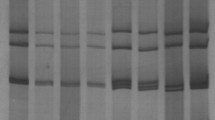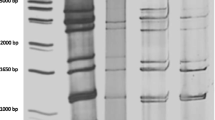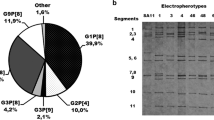Abstract
To describe the circulation dynamics of human rotavirus genotypes in a region of southern Europe over a 13-year period. The G- and P-types of rotavirus isolates of patients aged less than 5 years were analyzed using multiplex, reverse transcription polymerase-chain reaction. Of 1,538 isolates investigated, a combination of individual G- and P-types was obtained in 1,368. The most prevalent combination was G1[P8] (57.5% of the genotyped strains), which circulated in all seasons and predominated in nine out of 13 seasons. The strains G2[P4] (14.4%), G3[P8] (8.3%), G4[P8] (5.5%) and G9[P8] (13.4%) circulated intermittently. G4[P8] strains were frequently detected in the 1990s but only sporadically after 2000. G9[P8] strains emerged from 1997–1998 and became dominant in the winters of 2005–2007. G2[P4] strains were predominant in 2003–2004, before the rotavirus vaccines were commercialized. Unusual combinations of common G- and P-types and the presence of unusual G- and/or P-types (G6[P14], G8[P8], G8[P14] and G12[P8]) were rarely observed (<1%). We found no differences in hospitalization due to distinct genotypes. G-types G1-G4 and G9 represented >99% of circulating rotaviruses over a 13-year period. Therefore, vaccine efficacy in this region can be expected to be high.


Similar content being viewed by others
References
Parashar UD, Gibson CJ, Bresse JS, Glass RI (2006) Rotavirus and severe childhood diarrhea. Emerg Infect Dis 12:304–306
Forster J, Guarino A, Parez N, Moraga F, Román E, Mory O et al (2009) Hospital-based surveillance to estimate the burden of rotavirus gastroenteritis among European children younger than 5 years of age. Pediatrics 123:e393–e400
Charles MD, Holman RC, Curns AT, Parashar UD, Glass RI, Bresee JS (2006) Hospitalizations associated with rotavirus gastroenteritis in the United States, 1993–2002. Pediatr Infect Dis J 25:489–493
O’Ryan M, Díaz J, Mamani N, Navarrete M, Vallebuono C (2007) Impact of rotavirus infections on outpatient clinic visits in Chile. Pediatr Infect Dis J 26:41–45
Cortese MM, Parashar UD, Centers for Disease Control and Prevention (CDC) (2009) Prevention of rotavirus gastroenteritis among infants and children: recommendations of the Advisory Committee on Immunization Practices (ACIP). MMWR Recomm Rep 58(RR-2):1–25
World Health Organization (2009) Meeting of the immunization Strategic Advisory Group of Experts, April 2009—conclusions and recommendations. Wkly Epidemiol Rec 84:220–236
Kirkwood CD, Cannan D, Boniface K, Bishop RF, Barnes GL, Australian Rotavirus Surveillance Group (2008) Australian Rotavirus Surveillance Program annual report, 2007/08. Commun Dis Intell 32:425–429
Estes MK, Kapikian AZ (2007) Rotaviruses. In: Knipe DM, Howley PM (eds) Field’s virology, 5th edn. Lippincott Williams & Williams, Philadelphia PA (USA), pp 1917–1974
Santos N, Hoshino Y (2005) Global distribution of rotavirus serotypes/genotypes and its implication for the development and implementation of an effective rotavirus vaccine. Rev Med Virol 15:29–56
Iturriza-Gomara M, Kang G, Gray J (2004) Rotavirus genotyping: keeping up with an evolving population of human rotaviruses. J Clin Virol 31:259–265
Cilla G, Pérez-Trallero E, López-Lopategui MC, Gil-Setas A, Gomáriz M (2000) Incidence, seasonality and serotypes of rotavirus in Gipuzkoa (Basque Country), Spain. A 14-year study. Epidemiol Infect 125:677–683
Cilla G, Gomariz M, Montes M, Mendiburu MI, Pérez-Yarza EG, Pérez-Trallero E (2010) Incidence of hospitalization due to community-acquired rotavirus infection: a 12-year study (1996–2008). Epidemiol Infect 25:1–7. doi:10.1017/S095026881000004X
O’Ryan M (2009) The ever-changing landscape of rotavirus serotypes. Pediatr Infect Dis J 28(Suppl):S60–S62
de Rougemont A, Kaplon J, Lebon P, Huet F, Denis F, Alain S et al (2009) Unexpected substitution of dominant rotavirus G genotypes in French hospitalized children over five consecutive seasons. Eur J Clin Microbiol Infect Dis 28:403–407
Desselberger U, Wolleswinkel-van den Bosch J, Mrukowicz J, Rodrigo C, Giaquinto C, Vesikari T (2006) Rotavirus types in Europe and their significance for vaccination. Pediatr Infect Dis J 25(Suppl):S30–S41
Arista S, Giammanco GM, De Grazia S, Ramirez S, Lo Biundo C, Colomba C et al (2006) Heterogeneity and temporal dynamics of evolution of G1 human rotaviruses in a settled population. J Virol 80:10724–10733
Arista S, Vizzi E, Ferraro D, Cascio A, Di Stefano R (1997) Distribution of VP7 serotypes and VP4 genotypes among rotavirus strains recovered from Italian children with diarrhea. Arch Virol 142:2065–2071
Iturriza-Gómara M, Isherwood B, Desselberger U, Gray J (2001) Reassortment in vivo: driving force for diversity of human rotavirus strains isolated in the United Kingdom between 1995 and 1999. J Virol 75:3696–3705
Rahman M, Matthijnssens J, Goegebuer T, De Leener K, Vanderwegen L, van der Donck I et al (2005) Predominance of rotavirus G9 genotype in children hospitalized for rotavirus gastroenteritis in Belgium during 1999–2003. J Clin Virol 33:1–6
Reidy N, O’Halloran F, Fanning S, Cryan B, O’Shea H (2005) Emergence of G3 and G9 rotavirus and increased incidence of mixed infections in the southern region of Ireland 2001–2004. J Med Virol 77:571–578
Bányai K, Bogdán A, Domonkos G, Kisfali P, Molnár P, Tóth A et al (2009) Genetic diversity and zoonotic potential of human rotavirus strains, 2003–2006, Hungary. J Med Virol 81:362–370
Sánchez-Fauquier A, Montero V, Moreno S, Solé M, Colomina J, Iturriza-Gomara M et al (2006) Human rotavirus G9 and G3 as major cause of diarrhea in hospitalized children, Spain. Emerg Infect Dis 12:1536–1541
Gurgel RQ, Correia JB, Cuevas LE (2008) Effect of rotavirus vaccination on circulating virus strains. Lancet 371:301–302
Centers for Disease Control and Prevention (CDC) (2008) Rotavirus surveillance—worldwide, 2001–2008. MMWR Morb Mortal Wkly Rep 57:1255–1257
Van Damme P, Giaquinto C, Maxwell M, Todd P, Van der Wielen M, REVEAL Study Group (2007) Distribution of rotavirus genotypes in Europe, 2004–2005: the REVEAL Study. J Infect Dis 195(Suppl 1):S17–S25
Tcheremenskaia O, Marucci G, De Petris S, Ruggeri FM, Dovecar D, Sternak SL et al (2007) Molecular epidemiology of rotavirus in Central and Southeastern Europe. J Clin Microbiol 45:2197–2204
Maunula L, Von Bonsdorff CH (2002) Frequent reassortments may explain the genetic heterogeneity of rotaviruses: analysis of Finnish rotavirus strains. J Virol 76:11793–11800
Matthijnssens J, Potgieter CA, Ciarlet M, Parreño V, Martella V, Bányai K et al (2009) Are human P[14] rotavirus strains the result of interspecies transmissions from sheep or other ungulates that belong to the mammalian order Artiodactyla? J Virol 83:2917–2929
Bányai K, Bogdán A, Kisfali P, Molnár P, Mihály I, Melegh B et al (2007) Emergence of serotype G12 rotaviruses, Hungary. Emerg Infect Dis 13:916–919
Linhares AC, Verstraeten T, Wolleswinkel-van den Bosch J, Clemens R, Breuer T (2006) Rotavirus serotype G9 is associated with more-severe disease in Latin America. Clin Infect Dis 43:312–314
Cascio A, Vizzi E, Alaimo C, Arista S (2001) Rotavirus gastroenteritis in Italian children: can severity of symptoms be related to the infecting virus? Clin Infect Dis 32:1126–1132
Acknowledgments
This study was partially funded by the Department of Health of the Basque Country (project 2007111026).
Author information
Authors and Affiliations
Corresponding author
Rights and permissions
About this article
Cite this article
Cilla, G., Montes, M., Gomariz, M. et al. Rotavirus genotypes in children in the Basque Country (northern Spain) over a 13-year period (July 1996–June 2009). Eur J Clin Microbiol Infect Dis 29, 955–960 (2010). https://doi.org/10.1007/s10096-010-0951-x
Received:
Accepted:
Published:
Issue Date:
DOI: https://doi.org/10.1007/s10096-010-0951-x




